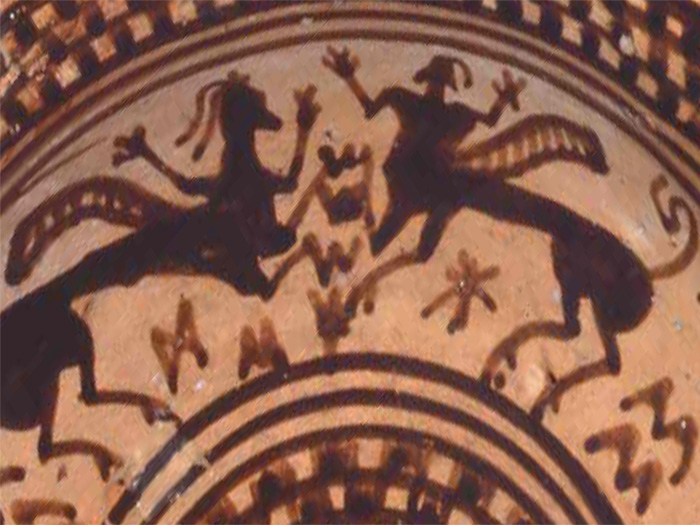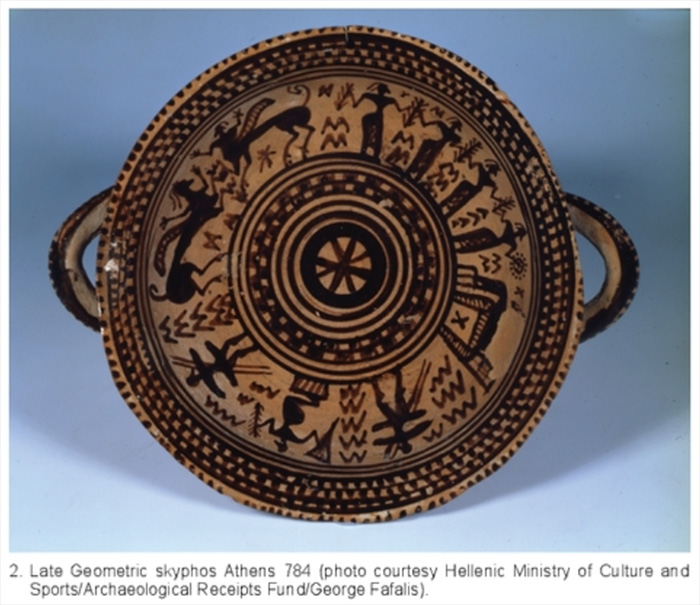|
Old Screeds
|
|
The Only Ancient Greek Wemic: the Athens 784 Skyphos
For 23 years I have been prowling the Internets for any signs of wemics in non-game contexts, mostly in art and mythology. I've found wemics in Ancient Assyria, antique Indus Valley civilization, and medieval Europe, most notably. What I have not found is any sign of wemics in Egypt, Ancient Greece, or Rome. Centaurs, sure. Sphinxes, yup. Humanoid people with feline heads, uh-huh. But no wemics in Greek culture, nada, nothing, nil.
Until now.
Browsing academic sources, I found a journal with cover art that made me gasp. Here's what I saw:

Two Ancient Greek Winged Lion-Centaurs Cavorting on Ceramic Pottery. (click to embiggen.)
I found these beauties on the cover of a journal with a Greek name and an English subhead; thankfully, the text inside included English. The journal is ΤΕΡΨΙΣ - Studies in Mediterranean Archaeology in Honour of Nota Kourou. The credits for the cover photo give more info:
Cover: Attic Late Geometric II skyphos (Athens NAM 784), from the Dipylon Grave 7. Workshop of Athens 894. Reproduced after permission of the National Archaeological Museum of Athens. Here's a PDF with the cover of the journal and one article from it: " Quadrupeds on relief pottery of the Aegen" -- which was interesting in general, but does not mention wemics, BTW.
The name of this particular piece of pottery is key, because I could use it as a search term: "Athens NAM 784." Pushing deep into the search results, I hit some pay dirt.
In a scholarly article ("Apollo Daphnephorus and the Niobid Painter: Tradition and Innovation in Plant Motifs on Attic Vases," c.750-400 BC, by Annette Kelaher, in the journal Mediterranean Archaeology, Vol. 32/33 (2019/2020), pp. 1-16.), the researcher talks about this piece at length, focusing on the worship of Apollo. Here's an excerpt:
To my knowledge, only one vase in the corpus of 8th to 6th-centuries vase=painting presents a scene that might depict Apollo Daphnephoros. This scene, on the Late Geometric skyphos Athens 784, may represent a religious ceremony at a sacred site. Four women holding branches and a wreath stand before an enthroned person; to the right, two Dipylon warriors are placed on either side of a male standing on a dias. This figure holds a branch in his left hand and a musical instrument, possibly a lyre, in his right. Beyond the warrior, on the left, two winged creatures complete the scene (emphasis mine).
Alas, Kelaher is not really much interested in our wemics. She does elaborate in a footnote. Carter art. cit. 46-8 pl. 11, concluding that these creatures represent sphinxes, possibly imitations of those seen on trade goods from Syria or Egypt.
But the real gem in this article is a great photo showing the entire pot from just the right angle to display those wemics perfectly.

Ancient Greek pottery designated Athens NAM 784.
Just look at those tails! So cat-like, both of them!
Another scholarly publication I found has a lot more to say about our "antithetical sphinxes," as the author calls them. Consider this long extract from Theodora Rombos's 1987 Ph.D. thesis, titled "The Iconography of Attic Late Geometric II Pottery, Vol. 1," Bedford College, University of London. (originally found at this link) The sphinx, a fantastic being consisting of a mixture of human and animal elements, defined from ancient Greek literature as having a lion body, wings and a female head, is represented in Attic Late Geometric II pottery by one unique example: it occurs in the interior of a skyphos (Athens NM 784, cat. no 202, PL.46b) belonging to the Athens 894 Workshop. The sphinxes are two, facing one another, while other figures complement the decoration: dancers, a seated figure and two Dipylon warriors. The iconographie type of the sphinx in the skyphos is not represented in a fully developed form; this fact has led many scholar s to interpret the two mixed-beings as winged centaurs. Certain features, however, do confirm the interpretation of sphinx, while the unusual features should rather be considered as a mere experimentation of an iconographie type which assumed a fixed and recognisable form only at the very end of the eighth century or even just after the turn of the century, as exemplified by the leading Proto attic painters (Table 36). The sphinxes of the Athens 784 skyphos have equine legs and hooves just like the centaurs; we must remember, however, that the contemporary Late Geometric centaurs do not have all four legs in equine form; the forelegs as we have seen, being rendered as human. The reason for seeing the monsters depicted in the skyphos as sphinxes and not centaurs is not the equine legs but the feline tail, apart of course from the wings; these latter almost never occurring on centaurs: only one winged centaur is seen in Greek art as exemplified by a Proto attic hydria in the Vlastos Collection by the Mesogeia Painter (Tolle, 1964, pi.19). The wings of the sphinxes are not rendered like those of other winged creatures such as winged goats, from the same workshop; the latter have wings rendered like a chequer board, whereas the wings of the sphinxes are hatched. Another unusual feature of the skyphos is the rendering of arms; arms are never represented on any sphinxes and should be understood as a misconception by the artist.
I very much appreciate Rombos's comments on the tails, which are indeed feline. I do not agree that the legs are equine; the drawing is not fine enough in detail to determine. And to her point about the arms being a "misconception" -- well, if the intent was to draw a sphinx, sure, but maybe the artist was drawing a lion-centaur!
27 May 2025 Update: Check out this PDF from the Metropolitan Museum of Art, "The Passas Painter." The work of this Greek artist is dated in the paper to about 700 BCE. The article, by Mary B. Moore. professor of art history, Hunter College of the City University of New York, mentions these lion-centaurs in footnote 71:
71. See CVA, Mainz 1 (Deutschland 15), pl. 19 (712).1, 4, and pl. 20 (713).2. For sphinxes, see the bibliography cited by Hampe, Grabfund, p. 84. For early representations, see Nikolaos M. Verdelis, "L'apparition du sphinx dans l'art grec aux VIII" et VIIe siecles avant J.-C.," Bulletin de correspondance hellenique 75 (1951), pp. 1-37; for a brief discussion of the spiral or floral ornament and a few examples of it, see pp. 6-7, 31. In Attic painting, the earliest example may be on a fragmentary Late Geometric II skyphos or cup in Athens NM 784 (Verdelis, "L'apparition du sphinx," p. 18, fig. 11, after AM 18 [1893], p. 113, fig. o1; Rombos, Iconography ... Late Geometric II, pp. 460-61, no. 202, pl. 46b, attributed by Rombos to the Workshop of Athens 894). The two winged figures on this cup have been interpreted as centaurs and as sphinxes (Verdelis, "L'apparition du sphinx," p. 18 n. i). Rombos (Iconography ... Late Geometric II, p. 461) calls them sphinxes. Their long, upturned tails with tufts argue for sphinxes. The floral on the sphinx by the Passas Painter may be one of the earliest, at least in Attic painting.
|